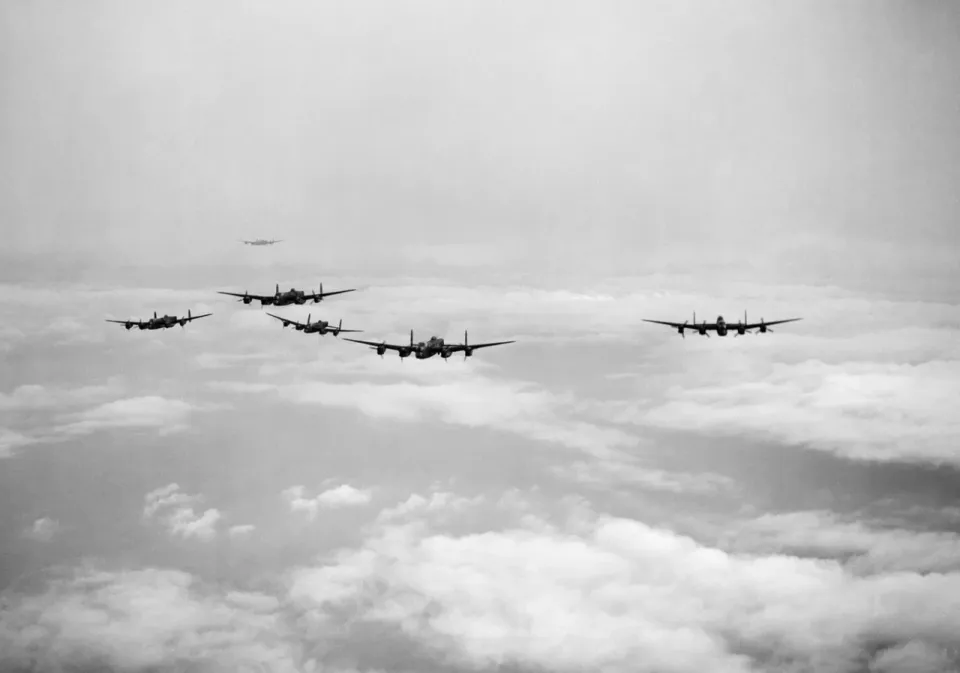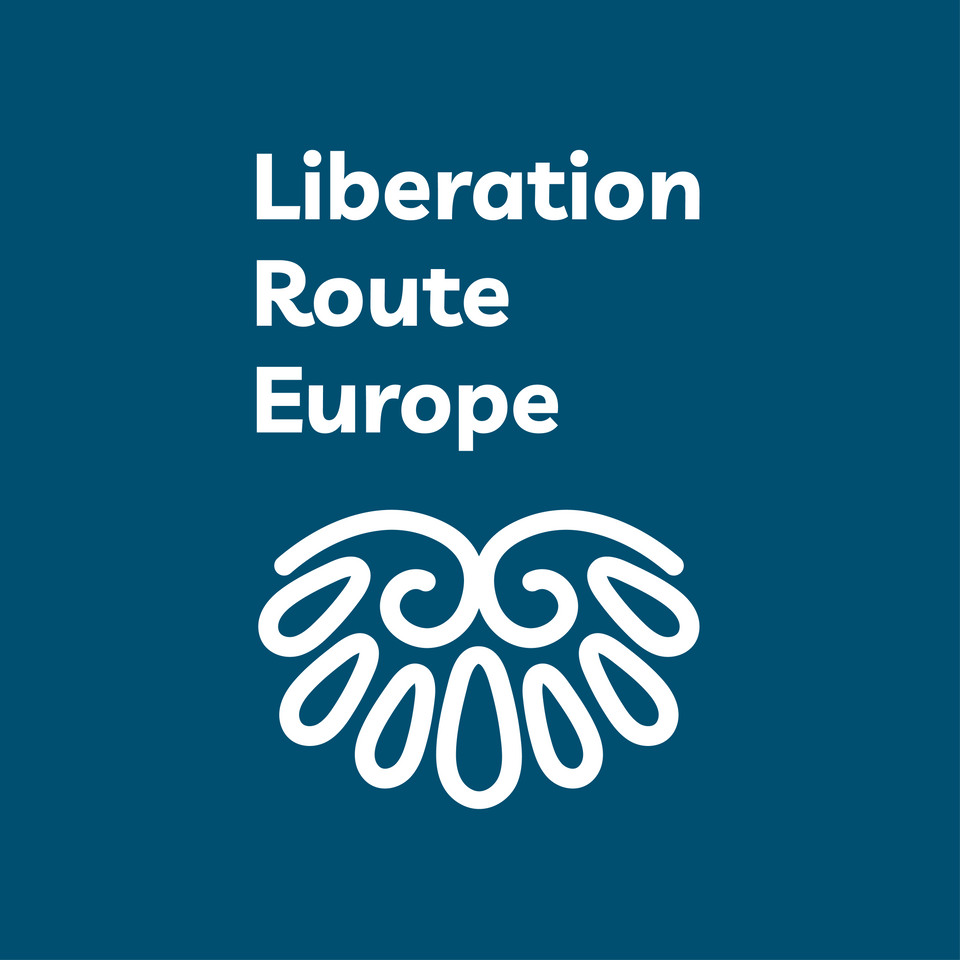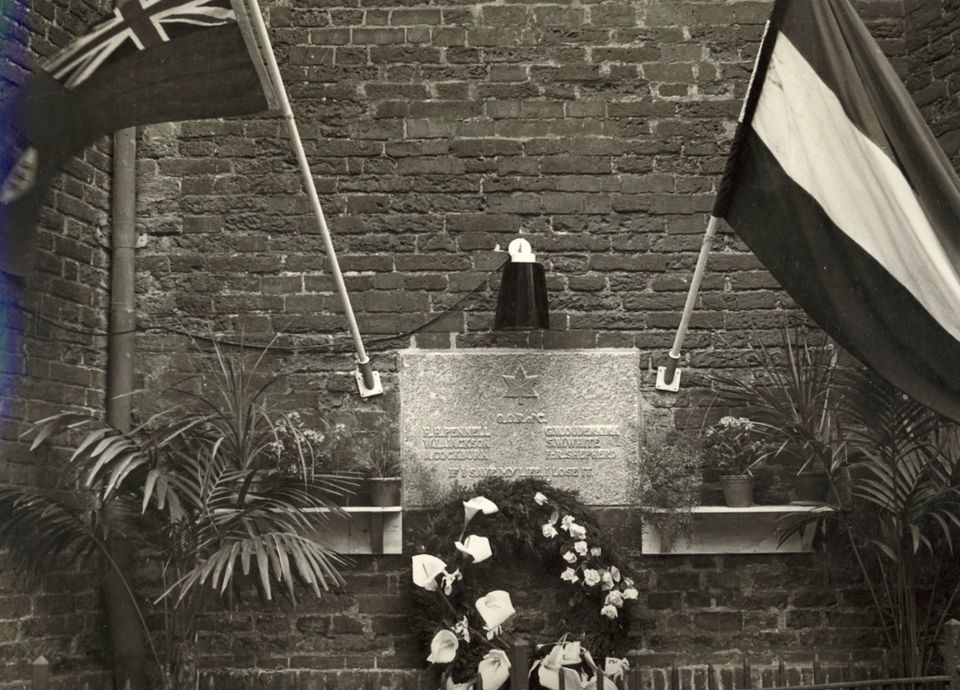Akkrum-IJlst | Liberation route: section 2
Fierce battles raged in the skies above Friesland throughout the occupation. Allied bombers heading for targets in Germany were constantly besieged by German (night) fighters taking off from the 'Fliegerhorst Leeuwarden'. Resulting in hundreds of casualties. In the immediate vicinity of this route through Friesland, aircrafts came down in Sonnega, Offingawier, Hieslum, among others, as well as in the IJsselmeer.
In many cemeteries, white tombstones are a tangible and striking reminder of the air war over Friesland, such as in Wolvega, Workum and Makkum. A significant number of crew members survived the crash after shelling and were brought to safety by Frisians. Frisian resistance fighters tried to get pilots to England at the risk of their own lives. Other airmen went into hiding with Frisian families and stayed until after the liberation.
During the…
Fierce battles raged in the skies above Friesland throughout the occupation. Allied bombers heading for targets in Germany were constantly besieged by German (night) fighters taking off from the 'Fliegerhorst Leeuwarden'. Resulting in hundreds of casualties. In the immediate vicinity of this route through Friesland, aircrafts came down in Sonnega, Offingawier, Hieslum, among others, as well as in the IJsselmeer.
In many cemeteries, white tombstones are a tangible and striking reminder of the air war over Friesland, such as in Wolvega, Workum and Makkum. A significant number of crew members survived the crash after shelling and were brought to safety by Frisians. Frisian resistance fighters tried to get pilots to England at the risk of their own lives. Other airmen went into hiding with Frisian families and stayed until after the liberation.
During the occupation, Friesland, Groningen and Drenthe were on the front line of the air war. Many Allied air routes to Germany were situated over these provinces. Especially during bombings on northern German cities, there was a constant coming and going of hundreds of heavy bombers. Initially, this was only done at night, but from 1943, it also happened during the day.
For protection, the occupying forces built a formidable defence line. Cities and key military targets were secured by anti-aircraft guns. In Friesland, anti-aircraft guns were located on the Wadden Islands, the coastal strip of Het Bildt, in Harlingen, Lemmer, Franeker and Gaasterland, and in the area around Leeuwarden airfield.
German observation posts gave directions to the Flieger Abwehr Kanone (Flak) to take Allied aircrafts out of the sky. Radar stations could detect enemy aircrafts as far away as 120 to 150 kilometres. The German radar positions in Friesland were 'Schlei' (Tench) on Schiermonnikoog, 'Tiger' (Tiger) on Terschelling, and 'Eisbär' (Polar Bear) near Sondel in Gaasterland.
Flak alone, however, proved insufficient to intercept the Allied bombers. During the first two years of the war, night fighter units were stationed at eight Dutch airfields, including Leeuwarden. From here, German pilots shot down hundreds of Allied planes. Most ended up in Friesland, Groningen, northern Drenthe, in the IJsselmeer and in the Wadden region.
The air war claimed many lives. Some 450 Allied aircrafts and about 150 German fighters are estimated to have crashed in Friesland during the war years. Fallen Allied crew members were usually buried in the nearest cemetery. German casualties were taken to the North Cemetery in Leeuwarden. Surviving Allied pilots were taken into captivity or went into hiding with the help of the resistance. Many pilots remain missing to this day. Some of them were buried as unknowns. On this spot, in the meadows near Offingawier, a US B-17 bomber, nicknamed 'Flying Fortress' crashed on 11 December 1943. Already over the province of Groningen, a number of German fighters launched the attack and partly as a result, the shot-up B-17 was damaged to such an extent that several crew members decided to abandon it. They made it to the ground safely. Door gunner Howard G. Hall and ball turret gunner Wilfred M. Husband, killed during the relentless attacks, were found in the wreckage.
After the war, the US victims were reburied at the American Military Cemetery in Margraten. The fallen Germans were interred in the German war cemetery in Ysselsteyn near Venray after the liberation. British, New Zealanders, Australians, South Africans and Canadians, along with Poles and Czechs, rest in fifty-seven different cemeteries in the province to this very day. The names of 511 are known; the others have unnamed graves.
Liberation Route Europe is a transnational memorial. A route that connects memorial sites and stories from all over Europe. For more information, visit www.liberationroute.com
Sights on this route
Starting point:
Waypoint walk 19
Akkrum
Navigate to starting point
Waypoint walk 19
Akkrum
Navigate to starting point
Terherne
Terherne is known as the Kameleon village and is an island in the Sneekermeer. On one side, you'll find the lake, and on the other side, the Terhernster ponds.
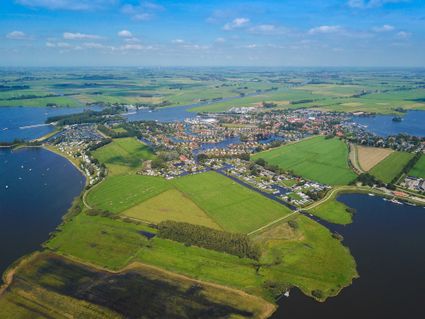
Veerpont Fietsa Versa (Terherne)
-Komt u aan als de pont er niet ligt? Pak per persoon (ook kleine kinderen) één van de 12 stokken als reservering voor de volgende afvaart. U kunt de schipper bellen om aan te geven dat u wilt overvaren. -Laatste afvaart: Terherne een half uur...

The bombing of Terherne lock
On 11 November 1944, pilots of the Royal Canadian Air Force, based at Welschap airfield near Eindhoven, were ordered to bomb the lock at Terherne in two groups. The reason for the bombardment of Terherne lock was to restrict (German) transport movements.
The bombing of Terherne lock
On 11 November 1944, pilots of the Royal Canadian Air Force, based at Welschap airfield near Eindhoven, were ordered to bomb the lock at Terherne in two groups. The reason for the bombardment of Terherne lock was to restrict (German) transport movements. The lock complex was situated on the main shipping route from Germany via Groningen to the Randstad, along which the Germans transported goods and military equipment.
After the railway strike in September had already disrupted rail transport considerably, actions against shipping traffic followed in the months thereafter. The southern part of the country may have been liberated, but fierce battles were still to be fought in the other parts.
Such was the case on that 11th November just after nine o'clock in the morning when the two groups of Hawker Typhoon fighter-bombers took off shortly after each other from Eindhoven for their mission. Around 10:00, the lock at Terherne was bombed from the north for the first time and then again around 10:30.
The consequences were huge for the people living on the lock. The wives of both lock keepers, a one-year-old baby and a German soldier were killed. Also, pilot John Gordon Fraser's aircraft was damaged to such extent that he had to make an emergency landing at St. Johannesga. Although the bombing resulted in the northern passageway being deactivated and no longer usable, the southern passageway remained open and could still be used.
Today, a boathouse for the State yacht of the province of Friesland has been built over the southern passage. A new building, that serves as a guest house for the province, was put up on the site of the lock keeper's house on the south side.
A monument has been erected on the northern pier in memory of those who perished at the lock. This monument was unveiled on 10 November 1985 by Hattum Hoekstra, son of 1st lock keeper Wiemer and Tietje Hoekstra. Since then, the commemoration of the dead in Terherne has always taken place at the old lock, and the children of primary school 'It Kampke' have adopted the monument.
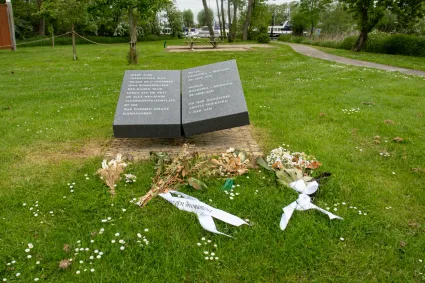
Memorial stone for Fallen Canadians
The 'Memorial Stone for Fallen Canadians' in the outer wall of the Martinikerk church in Sneek has been erected in memory of the six Canadian soldiers who died shortly after the liberation of the town.
Memorial stone for Fallen Canadians
Sunday 15 April 1945, Friesland's official liberation day, was also the day Sneek welcomed the Canadian liberation forces. It had been an exciting day, and the Dutch Domestic Armed Forces (NBS) had fought quite a battle with the occupiers.
A day earlier, German troops had begun to withdraw from Sneek and the NBS had tried to hinder their retreat along the Leeuwarderweg as much as possible. Until a column of German parachute troops had entered the fray and forced the NBS to retreat.
The Waag building in the middle of the city centre was used as a weapons cache by the occupying forces during the war. To prevent it from falling into Allied hands, the fleeing troops set it on fire at around three o'clock on Sunday. Loud explosions and bangs resounded throughout the city for half an hour.
Once the enemy had left the city, the NBS operatives gathered at the HBS school for instructions and the distribution of weapons and armbands. They went into the city to round up traitors. Then, rumour had it that hundreds of German soldiers were on their way to Sneek from Lemmer. Immediately, fortifications were built at the Water gate.
Canadian units were alerted. They were now in possession of the latest defence plans for Sneek thanks to NBS intelligence and were advancing from Joure towards the town.
In the evening around half past seven, the first patrol of the Canadian infantry battalion Le régiment De La Chaudière rode into town with flame-throwers and machine guns. The German troops stayed away, and the full Canadian battalion followed.
Sneek was liberated, but freedom was not yet guaranteed as German troops tried to escape via the Afsluitdijk towards Friesland. The Canadian Regiment of the Queens Own Rifles moved through Sneek to the Afsluitdijk and fiercely fought at Wons. Six Canadian soldiers were killed. They were temporarily buried at Sneek General Cemetery. In 1946, they were reburied at the Canadian Field of Honour in Holten.
Canadian guests
While waiting to return to their homeland, hundreds of Canadian soldiers were lodged with families in Sneek for about five months. On 1 June, the Perth Regiment arrived in the town, which they temporarily renamed Stratford. They were involved in the liberation of Groningen. A committee was set up to entertain the soldiers with various activities. From dances to sailing competitions and special church services.
Cordial ties developed between the liberators and the people of Sneek. And sometimes more than that. For Gordon C. Compton and Atty Bouma, one could even speak of "love at first sight". When the last soldiers return home at the end of November, Gordon decided to stay in the Netherlands. On 9 May 1946, he married Atty in Sneek. Not long after, Gordon and his "war bride" left for Canada.
Several monuments in the city recall the special bond with the Canadian military, which remains very close to this day.
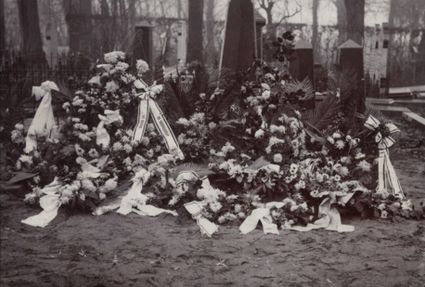
Sneek (Snits)
Sneek, or Snits as we say in Friesland, is the water sports city of the Netherlands. But Sneek is more than water sports and the Sneekweek. The city is bustling with events, culture, unique hotspots, and nice shops.

IJlst (Drylts)
IJlst (or Drylts in Frisian) is not only one of the famous 11 cities, but also a 'wood city'. For many years, tree trunks were processed here by the legendary wood trading companies Oppedijk and S.O. de Vries.

End point:
Waypoint walk 91
IJlst
Navigate to endpoint
Waypoint walk 91
IJlst
Navigate to endpoint
Directions
Starting point:
Waypoint walk 19
Akkrum
Navigate to starting point
The story of the Liberation of Western Europe is a book with many chapters, with some starting before the beginning of the war in 1939 and some others often ending years after the end of the conflict in 1945. Through the Liberation route Europe, you learn more about the storylines, key military events, personal stories and biographies from the second world war in Europe. Check out www.liberationroute.com for more routes, fragments and stories.
End point:
Waypoint walk 91
IJlst
Navigate to endpoint
- 19
- 13
- 64
- 63
- 65
- 19
- 60
- 50
- 43
- 41
- 42
- 70
- 71
- 91
